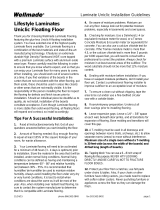
Wellmade®
Care and Maintenance
• Frequently moved furniture (chairs) should be equipped with felt pads to avoid scratching the floor and
checked regularly. Heavy furniture and appliances should be equipped with non-staining large surface
floor protectors. Furniture with castors or wheels must be easy swiveling, large surface non-staining and
suitable for wood floors. Do not use ball type castors as they can damage the floor.
• Avoid exposure to long periods of direct sunlight. Close blinds or drapes during peak sunlight hours
• Use walk-off mats at entrances to prevent dirt and grit from being tracked on to the floor.
• Move rugs periodically as wood will change color from UV exposure and oxidation.
• Sweep or vacuum the floor regularly to remove loose dirt. Avoid using a vacuum with a beater bar.
• Clean up spills immediately.
• Clean as needed using a hardwood floor cleaner and micro fiber dust mop. Do not use harsh cleaners or
chemicals on the floor.
Repairs
Small scratches can be blended in by using a common wood scratch treatment that is available from most
home improvement stores or flooring dealers. Larger scratches and gouges should be repaired by a
professional.
a. Scratch repair
Our finish contains aluminum oxide which helps to prevent deep scratches which will often require a
professional to repair. Light scratches on the surface are common and have a white appearance due to
the aluminum oxide. These type scratches can be made less visible by using scratch treatments that are
available in many home improvement or retail stores.
b. Deep scratches, and chips.
This type of damage will generally require a professional to repair. When repaired, gouges will often
be visible because the repair filler used for the repair is only one color when your flooring has many
shades of color, a mixture of color fillers will blend the repair better. More serious damage can be
repaired by removing the damaged plank and replacing it with a new plank. This should always be
done by a professional. For damaged planks that are n ot close to the perimeter, you may have to
remove the damaged planks and insert new planks without removing entire rows, this is easily
achievable.
1. Using a utility saw or equivalent, cut out the center of the damaged plank and leave
approximately a 1 - 2 inch strip attached to the inner portion of the adjacent planks.
2. Carefully cut back from the four corners of the plank to the inside edges, this is the space left
by the cut out plank.

3. Remove the plank edges carefully from the adjacent planks making sure the tongues and
grooves of the adjacent planks are not damaged.
4. Using a sharp utility knife, remove the tongue strip on both the long and short ends of the
replacement plank. In addition, remove the groove strip of the short end of the replacement
plank.
5. Position the replacement plank by engaging the groove of the long side into the tongue of the
adjoining plank and pushing down on the other three sides. Use “superglue” or equivalent to
hold the replacement plank in place with its adjacent planks.
/








